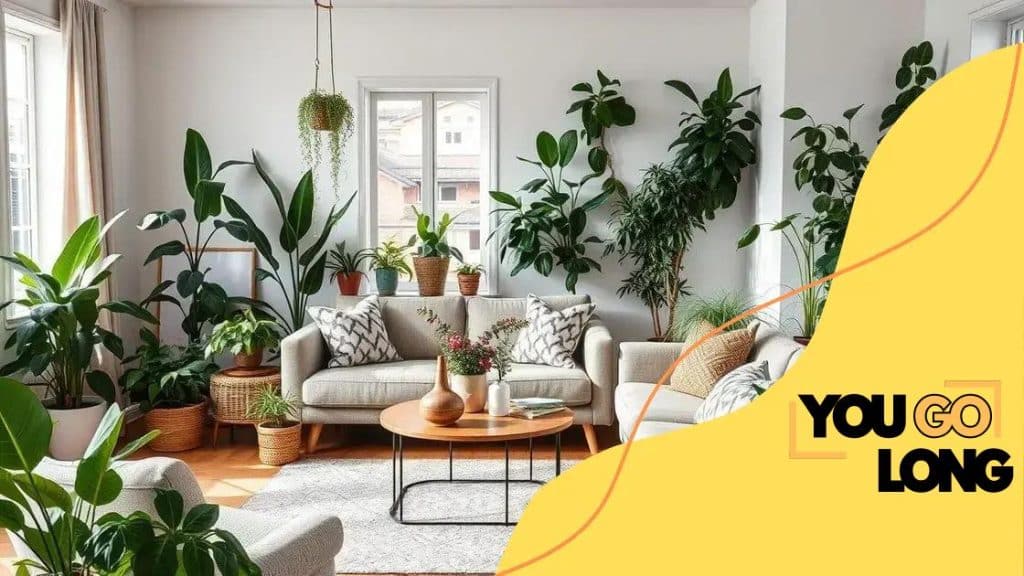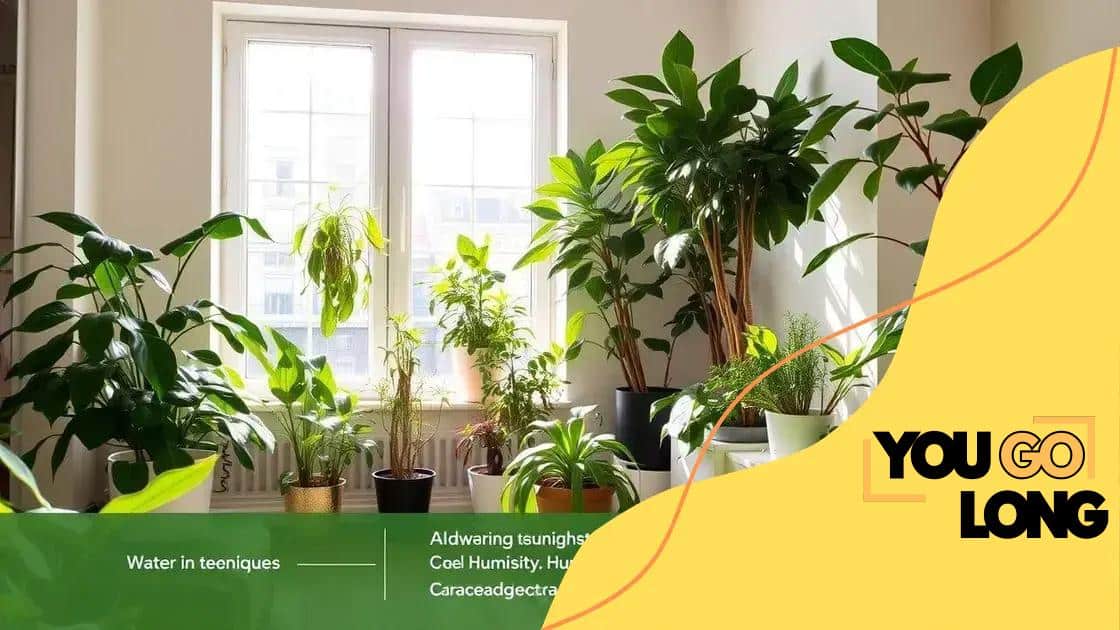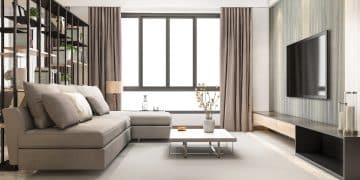How to decorate your home with indoor plants

Advertisement
To decorate your home with indoor plants effectively, choose suitable species, ensure proper lighting and watering, and avoid common mistakes like overwatering and poor plant compatibility.
How to decorate your home with indoor plants is more than just a trend; it’s a way to breathe life into your living spaces. Have you ever wondered how a touch of green can transform a room? Let’s explore some ideas that could inspire you.
Choosing the right indoor plants for your space
Choosing the right indoor plants for your space can greatly enhance your home’s ambiance. Indoor plants not only purify the air but also add color and life to your environment. It’s vital to consider factors like light, humidity, and space when selecting these green companions.
Understanding Light Requirements
Different plants thrive in varying light conditions. Some prefer bright, indirect sunlight, while others can tolerate low light. Knowing your space’s light availability is key.
Advertisement
- Choose snake plants for low light areas.
- Opt for succulents in well-lit areas.
- For bright rooms, consider ficus or tropical plants.
Once you’ve assessed your lighting, think about the size of your plants. Larger plants like fiddle leaf figs might work best in spacious living areas, while smaller varieties like pothos can fit on shelves or desks. It’s essential to balance the plant size with your available space.
Choosing Low-Maintenance Plants
If you’re new to indoor gardening or often have a busy schedule, consider low-maintenance options. Some plants are more forgiving than others and can thrive with minimal care. Zamioculcas zamiifolia, commonly known as the ZZ plant, is an excellent choice, requiring little water and attention.
Besides aesthetics, think about how plants can affect your mood. Studies show that having greenery around can reduce stress and increase happiness. Thus, placing a few peace lilies in your home could be a wonderful way to create a calming atmosphere.
Advertisement
Combining Plants with Decor
Integrating plants into your existing decor can also make your space more inviting. You can use stylish pots or hang plants from the ceiling to save space. Arrangement matters, so think about creating levels with plant stands or shelves.
Ultimately, the more you experiment with different types of plants, the more you’ll understand what works in your home. Pay attention to your plants’ behaviors and adjust care as needed. With a little patience, you’ll find the perfect indoor plants that enhance your living space beautifully.
Creative ways to display indoor plants
Creative ways to display indoor plants can transform your space into a vibrant, green oasis. By incorporating plants into your decor, you can enhance your home’s beauty while improving air quality. Let’s explore some unique and imaginative methods for showcasing your plants effectively.
Using Shelves and Ledges
One of the simplest ways to display indoor plants is by utilizing shelves and ledges. By combining different heights and plant types, you can create an engaging arrangement. Consider grouping plants by their light needs or colors for added visual appeal.
- Make use of wall-mounted shelves for space-saving displays.
- Group plants of similar sizes together for a cohesive look.
- Incorporate decorative pots to complement your furniture.
Such arrangements not only draw the eye but also make it easy to care for your plants. Regular watering and maintenance become more manageable when they are within reach.
Hanging Plants
Another creative option is to use hanging planters. They add dimension and draw attention to your plants without taking up valuable floor space. Choose hanging baskets with trailing plants like pothos or string of pearls to create a beautiful cascade.
Consider using macramé hangers for a boho touch or sleek metal hooks for a modern aesthetic. You can hang these planters from the ceiling or even in front of windows to enhance natural light exposure.
Combining different hanging styles can create a stunning focal point. It’s essential to ensure that your chosen plants are compatible with the intended space, so you have successful growth.
Display on Furniture
Another option is to showcase your plants on furniture. Use coffee tables, side tables, or even kitchen counters for a lively touch. Placing a tall plant beside a couch can draw attention and balance the room layout.
- Consider using plant stands for varying heights.
- Integrate plants in your dining table centerpiece.
- Mix plants with art or decorative items for contrast.
Natural elements like wood or ceramics for pots can tie everything together. By placing plants in key areas around your home, you can foster a refreshing atmosphere.
With these creative ways, it will be easy to choose how best to display your indoor plants. Think about your style and how plants can complement your space. This approach can lead to a harmonious balance within your home.
Caring for indoor plants: tips and tricks

Caring for indoor plants is essential for keeping them healthy and thriving. Each plant has its own unique needs, but some general tips and tricks can help you manage your indoor garden effectively. Understanding factors like water, light, and humidity is key.
Watering Wisely
Watering your plants properly is crucial. Overwatering can lead to root rot, while underwatering can cause wilting. A good rule of thumb is to check the soil moisture before watering.
- Stick your finger about an inch into the soil; if it feels dry, it’s time to water.
- Use room temperature water to avoid shocking the roots.
- Always ensure pots have drainage holes to prevent water buildup.
Each type of plant will have different watering needs, so it’s essential to research the specific requirements for your indoor plants.
Providing Adequate Light
Light is vital for plant growth. Most indoor plants prefer bright, indirect light, but some can thrive in lower light conditions. Observing where your plants are located can help you determine if they need more light.
- Rotate plants every few weeks to ensure all sides receive sunlight.
- Consider using grow lights if natural light is insufficient.
- Be cautious with direct sunlight, as it can scorch some plants.
By adjusting their position or adding supplemental lighting, you can enhance their growth and overall health.
Maintaining Humidity Levels
Indoor air can often be dry, especially during winter months. Many plants come from humid environments, so replicating these conditions can significantly benefit them. You can increase humidity through various methods.
Group plants together to create a microenvironment, or consider placing a humidifier near your plants. Regularly misting them with water can also help maintain necessary moisture levels.
By keeping an eye on humidity, you’ll promote lush foliage and vibrant growth in your indoor plants.
Caring for indoor plants doesn’t have to be complicated. With the right techniques and a little attention, you can create a thriving indoor garden that enhances your home.
The benefits of having indoor plants at home
The benefits of having indoor plants at home extend far beyond their beauty. Incorporating greenery into your living space can greatly enhance your well-being and overall environment. Plants offer various advantages, from improving air quality to boosting your mood.
Improving Air Quality
One of the most significant benefits of indoor plants is their ability to purify the air. Plants naturally absorb carbon dioxide and release oxygen, creating a healthier atmosphere. Certain plants can even absorb toxins from common household products.
- Spider plants are great for removing formaldehyde.
- Peace lilies help filter out ammonia and benzene.
- Areca palms are excellent for increasing humidity levels.
Adding these plants can lead to a noticeable improvement in your indoor air quality.
Boosting Mood and Mental Health
Having indoor plants can also boost your mood and mental health. Studies have shown that interacting with plants can reduce stress and anxiety. Simply being around greenery can create a calming effect, making it easier to relax at home.
Plants can also enhance productivity and creativity. Placing a few plants in your workspace may help you feel more focused and inspired. Additionally, caring for plants can bring joy and a sense of accomplishment.
Enhancing Aesthetic Appeal
Indoor plants add significant aesthetic value to any space. They come in various shapes, sizes, and colors, allowing you to personalize your home decor. Choosing the right plants can complement your furniture and create a cohesive design.
- Large plants like fiddle leaf figs can serve as stunning focal points.
- Smaller plants like succulents can fill empty spaces on desks or shelves.
- Hanging plants add dimension and interest to walls.
With so many options, it’s easy to find plants that match your unique style and preferences.
Having indoor plants at home also fosters a connection to nature. In our fast-paced lives, this connection can be soothing and refreshing. By integrating plants into your space, you’re not only enhancing the aesthetics but also improving your overall quality of life.
Common mistakes to avoid when decorating with plants
When decorating with plants, it’s important to avoid common mistakes that could hinder their growth and the overall aesthetic of your space. Many people may unknowingly make these errors, which can lead to unhappy plants or a cluttered look in their homes.
Overwatering and Underwatering
One of the most frequent mistakes is overwatering or underwatering your plants. Finding the right balance is crucial for healthy growth. Always check the soil moisture before watering. Many plants prefer to dry out slightly between waterings, and too much water can lead to root rot.
- Use pots with drainage holes to let excess water escape.
- Choose the right watering schedule based on the specific needs of each plant.
- Observe the leaves and soil for signs of over or under-watering.
By paying attention to your plants’ needs, you can keep them thriving.
Poor Lighting Conditions
Another common mistake is placing plants in unsuitable lighting conditions. Some plants thrive in bright, direct sunlight, while others prefer low light. Understanding your plants’ light requirements before selecting their spots is essential.
For example, placing a snake plant in a dark corner may cause it to become leggy and unhealthy. Instead, position it in a well-lit area or near a window that receives indirect sunlight. Investing in grow lights can help if natural light is limited in your home.
Ignoring Plant Compatibility
When decorating, it’s easy to overlook whether plants can coexist harmoniously. Some plants require different levels of care, which can complicate maintenance. For example, pairing a high-maintenance plant with a low-maintenance one may lead to problems.
Instead, group plants with similar care needs together. This approach makes it much easier to water, fertilize, and monitor their health. Grouping them also allows for a cohesive and well-designed look.
Placement and Scale Issues
Another mistake to avoid is poor plant placement and scale mismatches. Large plants, such as fiddle leaf figs, can overwhelm small spaces, while tiny plants may get lost in large areas. It’s important to consider the proportions of your plants in relation to your furniture and space.
- Use tall plants as focal points in corners.
- Place smaller plants on shelves or tables for added interest.
- Create levels by using stands or varying pot heights.
By paying attention to scale and placement, you can create a more visually appealing arrangement.
Avoiding these common mistakes will help ensure your indoor plants thrive and that your decor looks harmonious. A little planning and consideration can go a long way in enhancing your home with beautiful greenery.
Conclusion
Caring for indoor plants and decorating with them doesn’t have to be overwhelming. By understanding their needs and avoiding common mistakes, you can create a beautiful and thriving indoor garden. Remember to pay attention to watering, light, and placement for the best results. With just a little effort, plants can bring joy, health, and personality to your home.
FAQ – Frequently Asked Questions About Decorating with Indoor Plants
What are the best indoor plants for beginners?
Some of the best indoor plants for beginners include snake plants, pothos, and spider plants because they require minimal care and are resilient.
How often should I water my indoor plants?
Watering frequency depends on the plant type, but a general rule is to check the soil moisture and water when the top inch is dry.
Can indoor plants improve air quality?
Yes, many indoor plants can help purify the air by absorbing toxins and releasing oxygen, making your home healthier.
What common mistakes should I avoid when decorating with plants?
Common mistakes include overwatering, placing plants in wrong light conditions, and ignoring the compatibility of different plants.





